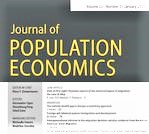A new article in the January 2020 issue of the Journal of Population Economics suggests that foreign aid may reduce asylum inflows from poor countries in the short run, but inflows from less poor economies show a positive but weak relation with aid. Aid is not an effective instrument to avoid migration flows.
Read more in:

Foreign aid, bilateral asylum immigration and development
Marina Murat
READ LINK: https://rdcu.be/bXofD
Journal of Population Economics 33 (2020), 79–114
GLO Discussion Paper No. 378, 2019.
GLO Fellow Marina Murat
Author Abstract: This paper measures the links between aid from 14 rich to 113 developing economies and bilateral asylum applications during the years 1993 to 2013. Results show that asylum applications are related to aid in a U-shaped fashion with respect to the level of development of origin countries, although only the downward segment proves to be robust to all specifications. Asylum inflows from poor countries are significantly and negatively associated with aid in the short run, with mixed evidence of more lasting effects, while inflows from less poor economies show a positive but non-robust relationship to aid. Moreover, aid leads to negative cross-donor spillovers. Applications linearly decrease with humanitarian aid. Voluntary immigration is not related to aid. Overall, the reduction in asylum inflows is stronger when aid disbursements are conditional on economic, institutional and political improvements in the recipient economy.
Read also the Lead Article of issue 1 (2020):
Hate at first sight? Dynamic aspects of the electoral impact of migration: the case of Ukip
Eugenio Levi, Rama Dasi Mariani & Fabrizio Patriarca
FREE READ LINK: https://rdcu.be/bXnWI
Journal of Population Economics, Vol. 33 (2020), Issue 1 (January), pp. 1-32.
GLO Fellows Eugenio Levi, Rama Dasi Mariani & Fabrizio Patriarca
Complete issue 1, read access to all articles.
Ends;

